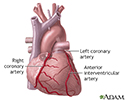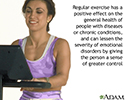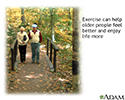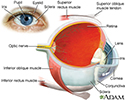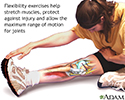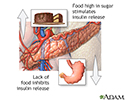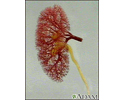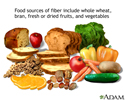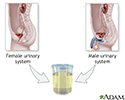Multimedia Gallery
Stroke
When blood flow to an area of your brain stops, it's serious. It's called a stroke, and will often cause permanent, debilitating damage to your brain and change your life. Let's talk about strokes. If blood flow to your brain is stopped for longer than a few seconds, your brain can't get blood and oxygen. Brain cells die, causing permanent damage. There are two types, ischemic stroke and hemorrhagic stroke. Ischemic stroke happens when a blood clot forms in a very small artery, or when a blood clot breaks off from another artery and lodges in your brain. Hemorrhagic strokes can happen when a blood vessel in your brain becomes weak and bursts open. High blood pressure is the number one risk factor for strokes.
People with atrial fibrillation (when your heart rhythm is fast and irregular), diabetes, a family history of stroke, and high cholesterol are most at risk. You are also at risk for stroke if you are older than age 55. Other risk factors include being overweight, drinking too much alcohol, eating too much salt, and smoking. Symptoms of a stroke usually develop suddenly, without warning. You may have a severe headache that starts suddenly, especially when you are lying flat, often when you awake from sleep. Your alertness may suddenly change. You may notice changes in your hearing, your sense of taste, and your sense of touch. You may feel clumsy or confused or have trouble swallowing or writing.
So, how are strokes treated?
A stroke is a medical emergency. Immediate treatment might save your life and reduce disability. Call your local emergency number -- or have someone call for you -- at the first sign of a stroke. Most of the time, someone having a stroke should be in the hospital within three hours after symptoms first begin. If a doctor suspects you've had a stroke, the doctor will check for problems with your vision, movement, feeling, reflexes, and your ability to understand and speak. You may have several tests to check for blocked or narrowed arteries. If the stroke is caused by a blood clot, you'll be given a clot-busting drug to dissolve the clot.
Treatment depends on how bad your stroke is and what caused it. But you will probably need to stay in the hospital for a few days. Besides clot-busting drugs (called thrombolytics), you may need blood thinners, medicine to control high blood pressure, and surgery to unclog one of your carotid arteries-which carry blood to the brain. After your stroke, treatment will focus on helping you recover as much function as possible, and preventing future strokes. Most people need stroke rehabilitation therapy. If you can return home, you may need help making safety changes in your home and to help you with using the bathroom, cooking, dressing, and moving around your home.
After a stroke, some people have trouble speaking or communicating with others, and a speech therapist might help. Depending on the severity of the stroke, you may have trouble with thinking and memory, problems with your muscles, joints, and nerves, trouble going to the bathroom, and difficulty swallowing and eating. Therapies and support for you and your family are available to help with each of these problems. Your treatment will also focus on preventing another stroke. You may need to be on several medications to help prevent this. And, eating healthy and controlling problems like diabetes and high blood pressure can be very important.
Stroke
Review Date: 7/17/2025
Reviewed By: Joseph V. Campellone, MD, Department of Neurology, Cooper Medical School at Rowan University, Camden, NJ. Review provided by VeriMed Healthcare Network. Also reviewed by David C. Dugdale, MD, Medical Director, Brenda Conaway, Editorial Director, and the A.D.A.M. Editorial team.
Animations
- Blood pressure
- Bunion
- Cataract
- Childhood obesity
- Cholesterol and triglycerid...
- Coronary artery disease
- Depression
- Diabetes
- Diabetes - retinal conditions
- Diabetes and risk of seriou...
- Dialysis
- Erection problems
- Exercise
- Foot pain
- Gallstones
- Glaucoma
- Hardening of arteries
- HbA1c
- Healthy Guide to Fast Food
- Heart attack
- Hypertension
- Hypertension - overview
- Immune response
- Smoking
- Smoking tips to quit
- Stroke
- Stroke
- The goals of proper type 2 ...
- Tobacco use - effects on ar...
- Tracking your blood pressur...
- Type 1 diabetes
- Type 2 diabetes
- Understanding cholesterol r...
- Urinary incontinence
- Urinary tract infection - adults
- Vaccines
- Venous insufficiency
Illustrations
- 15/15 rule
- Abdominal girth measurement
- Abdominal muscles
- Acanthosis nigricans - close-up
- Acanthosis nigricans on the hand
- Acute MI
- Adjustable gastric banding
- Aerobic exercise
- Alpha-glucosidase inhibitors
- Angina
- Anterior heart arteries
- Atherosclerosis of the extr...
- Autonomic Nerves
- Baby bottle tooth decay
- Benefit of regular exercise
- Biguanides
- Blood pressure
- Blood pressure check
- Blood test
- Blood test
- Brain
- Brainstem function
- Calculating body frame size
- Candida - fluorescent stain
- Candidiasis, cutaneous - ar...
- Carotid dissection
- Carotid stenosis - X-ray of...
- Carpal tunnel syndrome
- Cataract - close-up of the eye
- Central nervous system
- Central nervous system and ...
- Cerebellum - function
- Childhood obesity
- Children's diets
- Cholesterol
- Cholesterol producers
- Circle of Willis
- Circulation of blood throug...
- Complex carbohydrates
- Coronary artery blockage
- Coronary artery disease
- Creatinine tests
- DASH diet
- Dermatitis - reaction to tinea
- Dermatitis - stasis on the leg
- Developmental process of at...
- Diabetes and exercise
- Diabetes and nerve damage
- Diabetes risk factors
- Diabetic blood circulation ...
- Diabetic emergency supplies
- Diabetic foot care
- Diabetic foot care
- Diabetic nephropathy
- Diabetic retinopathy
- Different types of weight gain
- Digestive system
- Endarterectomy
- Endocrine glands
- Energy levels
- Exercise - a powerful tool
- Exercise 30 minutes a day
- Exercise and age
- Exercise and heart rate
- Exercise can lower blood pr...
- Exercise with friends
- Eye
- Fast food
- Fasting plasma glucose test
- Female reproductive anatomy
- Female urinary tract
- Femoral nerve damage
- Fish in diet
- Flexibility exercise
- Follicle development
- Folliculitis - decalvans on...
- Folliculitis on the leg
- Food and insulin release
- Food label guide for candy
- Food label guide for whole ...
- Foot swelling
- Fruits and vegetables
- Fungus
- Gestational diabetes
- Gingivitis
- Gingivitis
- Glaucoma
- Glucose in blood
- Glucose test
- Granuloma - fungal (Majocchi's)
- Granuloma - fungal (Majocchi's)
- Granuloma annulare - close-up
- Granuloma annulare on the elbow
- Granuloma annulare on the eyelid
- Granuloma annulare on the legs
- Hair follicle anatomy
- Hammer toe
- Healthy diet
- Healthy diet
- Heart - front view
- Heart - section through the...
- Heart attack symptoms
- High blood pressure tests
- Influenza
- Influenza vaccines
- Ingrown toenail
- Insulin production and diabetes
- Insulin pump
- Insulin pump
- Islets of Langerhans
- Isometric exercise
- Jaw pain and heart attacks
- Kidney - blood and urine flow
- Kidney anatomy
- Kidneys
- Left cerebral hemisphere - ...
- Lifestyle changes
- Lipocytes (fat cells)
- Low blood sugar symptoms
- Male urinary system
- Male urinary tract
- Monitoring blood pressure
- myPlate
- Nail infection - candidal
- Necrobiosis lipoidica diabe...
- Necrobiosis lipoidica diabe...
- Nervous system
- Nervous system
- Normal uterine anatomy (cut...
- Obesity and health
- Omega-3 fatty acids
- Oral glucose tolerance test
- Osmolality test
- Pancreas
- Pancreas and kidneys
- Pelvic laparoscopy
- Pesticides and fruit
- Pharmacy options
- Physical activity - prevent...
- Pituitary and TSH
- Plaque buildup in arteries
- Pneumococcal vaccine
- Post myocardial infarction ...
- Posterior heart arteries
- Prevention of heart disease
- Progressive build-up of pla...
- Proteins
- Quitting smoking
- Radial nerve dysfunction
- Read food labels
- Retinal dye injection
- Right cerebral hemisphere -...
- Ringworm - tinea corporis o...
- Ringworm - tinea corporis o...
- Ringworm - tinea manuum on ...
- Ringworm - tinea on the han...
- Ringworm of the scalp
- Ringworm, tinea capitis - c...
- Roux-en-Y stomach surgery f...
- Salad nutrients
- Saturated fats
- Secondary infection
- Simple carbohydrates
- Slit-lamp exam
- Smoking hazards
- Sources of fiber
- Soy
- Stable angina
- Starchy foods
- Stein-Leventhal syndrome
- Stomach
- Stomach disease or trauma
- Stye
- Sulfonylureas drug
- Surface anatomy - normal palm
- Surface anatomy - normal wrist
- Swollen gums
- Thiazolidinediones
- Thyroid uptake test
- Tinea corporis - ear
- Tinea versicolor - close-up
- Tinea versicolor - close-up
- Tinea versicolor - shoulders
- Tinea versicolor on the back
- Tooth anatomy
- Tooth anatomy
- Trans fatty acids
- Type I diabetes
- Ulnar nerve damage
- Untreated hypertension
- Urine sample
- Uterus
- Vaginal discharge
- Visual field test
- Vitiligo
- Vitiligo - drug induced
- Vitiligo on the back and arm
- Vitiligo on the face
- Weight loss
- White nail syndrome
- Wood's lamp test - of the scalp
- Wrist anatomy
- Xerosis - close-up
- Yeast and mold
- Yeast infections
- Yoga
- Yo-yo dieting

 Bookmark
Bookmark















































